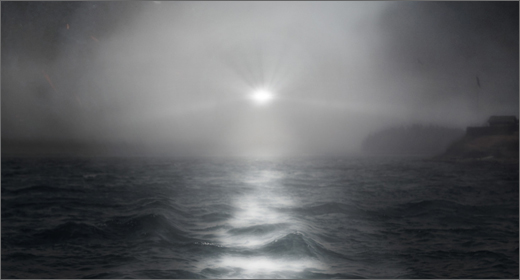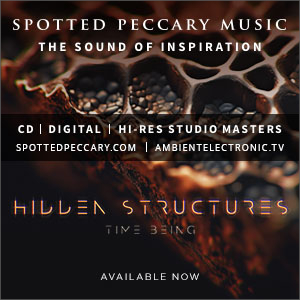Everyday Dust has achieved a record replete with stimulating visuals, haunting quality, and lasting impact.
I have listened to Everyday Dust’s The Principality of Dustland somewhere in the vicinity of 40 times now, and find myself still at somewhat of a loss on how to go about describing this album besides saying that I absolutely love it. It needs more, and specific praises. That being the case, it may be an abstract review from here on out, much like Principality of Dustland is abstract, highly visual, and completely enthralling.
Accompanying the album is a series of ten black-and-white photos, intended to give the listeners a clear visual launchpad from which to relate to the album. The photos are joined by a poem, artfully declaiming a “Traveller’s Impression of A Journey to the Principality by Hot-Air Balloon.” Both of these additions to the album serve the music wonderfully, and build a strong, and complete, image of the intended scenery on the part of Everyday Dust. The photos are a fantastic visual aid, and the poem is very evocative, but I take slight issue with their inclusion.
My problem with these additions is that they aren’t what I imagine when I listen to the record. At all.
The Principality of Dustland is, to me, the soundtrack of a book I recently read: Frank Herbert’s Destination Void. It is every bit as eerie, surreal, complex, beautiful, and addictive as The Principality of Dustland, and it is incredibly thought provoking. Destination Void, the first novel in the Worship novels series, deals with the convolutions and nuances of creating artificial intelligence, the development and expansion of human capacity and consciousness, and the interjection of insanity. The story takes place on a spaceship, populated with an army of sleeping clones, manned by a staff of six specialists who, through a series of far-out discussions, determine that their only hope of survival is to force the controlling computer (made of human brains, incidentally,) to “awaken.” This, understandably, leads to an array of problems, culminating with the creation of real A.I. and the subsequent ascension of that A.I. to godhood. Sorry if I spoiled it for you there. Regardless, I highly recommend reading it. It’s an incredible book that left me wrapped in thought for weeks after I finished it.
The Principality of Dustland’ is the perfect accompaniment to this book. From the opening notes of “Foghorn,” I see a large, spherical ship ominously floating through the dust of a nebula, as the repetitive, chromatically-shifting melody acts as an introduction as we’re swept into the depths of the ship, and over the small cast of characters. The drums decompose and recompose into a bed of noise in the background, while strings carry the ominous tone until the return of the main melodic theme. In “Foghorn,” I see the crew at the ship’s helm, each on their action couches, examining printouts from the OMC (organic mental core,) gleaning only the beginning of the troubles that will soon begin to pursue them. There’s water, wind, and air in the track, but that doesn’t take me out of the feeling of open space. It bolsters it.
“Towers” follows, a strong, booming bass holding down the lower end as strings and reversed-distorted-noise set the scene. As sounds resembling pinch-harmonics take over, a theme coalesces, and reminds me of a portentous red light, flashing with alarm, marking the beginning of the first troubles for our ship and crew. The melody is simple, but the effects running over it, and the strings below, paint a wide and sonorous scene, oozing with tension and beauty. The ship flies, silently, through space, tiny bits of dust tinkling along its fuselage as it passes.
The eerie feeling of the album only grows with “Ferryman’s Toll,” the sonorous alarm shifting to a regular, rhythmically consistent tone. The percussion on the track is fantastic, subtle, and lends a sense of urgency to the tune as a whole. The strings, as they work through their tense melody, illustrate the tension within the crew as they discover their plight: the planet their destined for isn’t habitable, turning back isn’t an option, and they’re all going to die if the don’t come up with a new plan, and fast.
“Above the Fog” pulls back a bit, though the presence of an alarm-like sound reminds us of the problems awaiting us on the other side of this calm patch. From here, looking out onto the nebula, through outboard cameras, our crew revels in the beauty of open space, the busy, dusty, bright nebula they’re traversing calling to them with its overwhelming enormity. It’s a deep breath before a second plunge.
We return to the task at hand with “Waltz,” our cast setting their considerable intellects against the problems that face them. The gorgeous synths, pulsating rhythm section, falling droplets, and rumbling bass lines stand in contrast to the tension and nerves generated by the earlier tracks on the record. There is resolve and growing excitement in the tune, built of widening chords and spreading percussive sounds, the droplets resolving into xylophonic tinkles floating atop a growing wind of white noise.
“Pipes” retains that resolve, the wholeness, that “Waltz” began. It is smooth, and calm, in despite of the return of that alarm-like tone that invaded those first tracks, which is drowned by a growing, swelling minor chord progression that dazzles in its combination of tonal clarity and noisy filling. As the progression repeats, I find that I’m swaying with it, and that I can see the dust of space, like a fog, obscuring the light of the heart of that nebula just enough to cast shadows.
With “Quintessence,” we are introduced immediately to a pure, strong note from wind instruments, accompanied by the familiar tinkling percussion that is present in so many of the other tracks. A voice, for the first time on the record, admits that “we’re not gonna have bad dreams,” and the pleasant tones of the wind instruments is a testament to that. The tune is subtle, relatively quiet, and subdued. It shows the versatility of Everyday Dust, and the breadth of this record’s emotional beats.
Aptly named, “Ticking Heart” sounds like an insider’s perspective on some alternate-history Victorian clockwork automaton. At the same time, in keeping with the strong sci-fi theme of the album, I see this moment as the final approach the crew makes to the Organic Mental Core, in their audacious and groundbreaking attempt to awaken it, converting it into a living, thinking intelligence. The ticking could just as easily represent echoing footsteps as the crew reaches the main deck, and gains access to the hatch containing the central core, as it could represent that clockwork automaton. The melodies and chiming brass sounds backing that click are gorgeous, and as the ticking grows in speed, it’s attack grows less tense, balancing the rising energy with a fall in abrasion.
“Canticle,” to me, sounds like the first, cautious pings of the awakened core. Exploring its new environments, suddenly emboldened by the almost limitless power of intelligence unbound by flesh, we meet the eerie bells that toll the doom of the crew as the A.I. proclaims its own godhood. The resolving, deep brass notes accompanied by the higher bells sound like the ushering-in of a new age, one of combined awe and horror, at what the results of this dangerous experiment have brought to bear. It is beautiful in its clarity, and oppressive in its boundless width, and it is, above all, incredibly evocative. It is a calm, but powerful crescendo.
The album closes with “The Lantern Room,” which opens to the sound of wind, followed quickly by an eerie pipe organ, which makes me think immediately of a funeral. The dirge is thoughtful, melancholy, ghostly, and altogether spectacular. It closes this fascinating record with excellent cadence, and leaves wind, leaves, and chirps behind as it fades away.
The Principality of Dustland is nothing short of incredible, and is high in the contending as best record of 2014 in my book, which has been a fantastic year for music in general. Everyday Dust has achieved a record replete with stimulating visuals, haunting quality, and lasting impact that left me unable to fully articulate my appreciation for the record until now. Thanks for bearing with the abstraction and tangential review, but that’s what the album pulled from me. I highly recommend giving it a listen. It’s a powerful record.
The Principality Of Dustland is available on Sparkwood.
























![Luke’s Anger :: Ceiling Walker EP (Love Love) — [concise]](https://igloomag.com/wp/wp-content/uploads/2025/04/lukes-anger-ceiling-walker-vinyl_feat-75x75.jpg)


